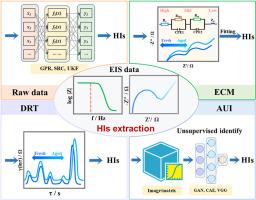电化学阻抗谱法提取锂离子电池健康状态评价指标
IF 17
1区 工程技术
Q1 ENERGY & FUELS
引用次数: 0
摘要
准确实时评估锂离子电池的健康状态(SOH)对于确保锂离子电池的安全运行至关重要。电化学阻抗谱(EIS)由于其无损、快速响应和丰富的电化学信息,已成为一种成熟的SOH估算技术。因此,核心挑战是从EIS数据中提取潜在健康指标(HIs),以建立稳健的SOH映射模型。本文首先介绍了SOH的定义和EIS的基本原理;在此基础上,综述了基于ais的HIs提取方法的研究进展,包括原始数据、等效电路模型(ECM)、松弛时间分布(DRT)和自动无监督识别(AUI)分析。至关重要的是,这项工作总结了将HIs提取方法与SOH估计联系起来的技术路线,并首次对AUI和传统技术进行了系统比较。这些方法利用先进的经验模型和人工智能来有效地识别和量化性能下降的关键HIs。此外,对这些方法的优缺点进行了介绍、分析和比较。最后,从机制、测量和应用三个方面讨论了加强SOH估算的前景和挑战。总体而言,本综述为推进基于is的SOH估计提供了理论框架和技术路线,同时概述了无损评估技术、测量设备和电池组级SOH监测的未来路线图。本文章由计算机程序翻译,如有差异,请以英文原文为准。

Extraction of health indicators from electrochemical impedance spectroscopy for state of health estimation of lithium-ion batteries
Accurate real-time assessment of the state of health (SOH) of lithium-ion batteries is critical for ensuring their safe operation. Owing to its non-destructive nature, rapid response, and abundant electrochemical information provided, electrochemical impedance spectroscopy (EIS) has become a well-established technique for SOH estimation. Hence, the core challenge is to extract potential health indicators (HIs) from EIS data in order to establish robust SOH mapping models. This review initially introduces SOH definitions and the fundamental principles of EIS; then, it comprehensively surveys the research progress made in EIS-based approaches for HIs extraction, including raw data, equivalent circuit model (ECM), distribution of relaxation times (DRT), and automatic unsupervised identification (AUI) analyses. Crucially, this work summarizes the technical routes connecting HIs extraction methods to SOH estimation and provides the first systematic comparison of AUI and conventional techniques. These approaches leverage advanced empirical models and artificial intelligence to effectively identify and quantify key HIs of performance degradation. Furthermore, the advantages and limitations of these approaches are introduced, analyzed, and compared. Finally, the outlook and challenges for enhancing the SOH estimation are discussed from three perspectives: mechanisms, measurements, and applications. Overall, this review provides a theoretical framework and a technical route for advancing EIS-based SOH estimation, while outlining a future roadmap for non-destructive evaluation technologies, measurement devices, and battery pack-level SOH monitoring.
求助全文
通过发布文献求助,成功后即可免费获取论文全文。
去求助
来源期刊

Etransportation
Engineering-Automotive Engineering
CiteScore
19.80
自引率
12.60%
发文量
57
审稿时长
39 days
期刊介绍:
eTransportation is a scholarly journal that aims to advance knowledge in the field of electric transportation. It focuses on all modes of transportation that utilize electricity as their primary source of energy, including electric vehicles, trains, ships, and aircraft. The journal covers all stages of research, development, and testing of new technologies, systems, and devices related to electrical transportation.
The journal welcomes the use of simulation and analysis tools at the system, transport, or device level. Its primary emphasis is on the study of the electrical and electronic aspects of transportation systems. However, it also considers research on mechanical parts or subsystems of vehicles if there is a clear interaction with electrical or electronic equipment.
Please note that this journal excludes other aspects such as sociological, political, regulatory, or environmental factors from its scope.
 求助内容:
求助内容: 应助结果提醒方式:
应助结果提醒方式:


